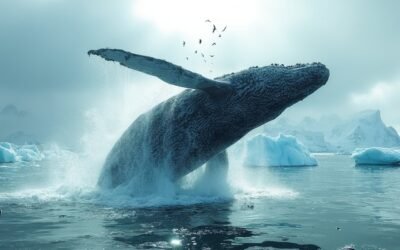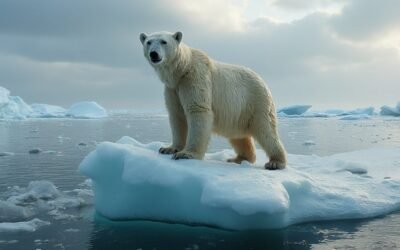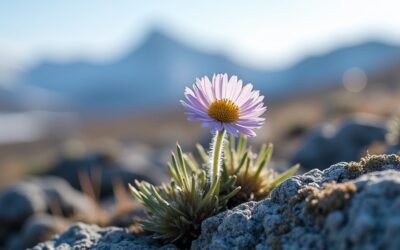Reindeer greatly enhance the Arctic ecosystem through their grazing habits. First, they maintain the tundra by preventing overgrowth of woody shrubs, preserving open landscapes and aiding in carbon sequestration. Second, their grazing activity reduces undergrowth, which acts as a carbon sink, balancing shrub growth and mitigating CO2 release. Finally, by preserving snow cover and sustaining high albedo levels, they help reflect sunlight, keeping the tundra cooler. These actions contribute to the overall stability and resilience of the Arctic ecosystem. Discover additional advantages and mechanisms by exploring further on this topic.
Main Points
- Reindeer grazing prevents woody shrub overgrowth, preserving open landscapes and enhancing snow reflectivity in the Arctic tundra.
- Supporting reindeer herding by the Sami people helps maintain the delicate balance of the Arctic ecosystem and snow cover.
- Reindeer grazing slows tundra greening, contributing to climate change mitigation and moderating global temperatures.
- Managing reindeer populations can control undergrowth, acting as a carbon sink and stabilizing carbon levels.
- Reindeer activity sustains high albedo levels by reflecting sunlight and preserving snow cover, keeping the tundra cooler.
Reindeer Grazing Benefits
Reindeer grazing plays an essential role in maintaining the Arctic tundra ecosystem by preventing the overgrowth of woody shrubs and preserving open landscapes. This natural behavior is critical in sustaining the tundra habitat, which is fundamental for various ecological processes in Arctic regions. The presence of reindeer curtails woody shrub growth, thereby maintaining the open landscapes that are characteristic of the tundra. This grazing activity enhances snow reflectivity, an important factor in the albedo effect, which helps to moderate global temperatures by reflecting sunlight.
Additionally, reindeer grazing mitigates the impacts of climate change by slowing down the greening of the tundra. This deceleration is significant as it counteracts the tendency for the tundra to turn into shrub-dominated landscapes, which can otherwise amplify warming effects. Research indicates that these grazing practices contribute to carbon sequestration, as they reduce the amount of decomposing biomass that releases CO2. This function underscores the ecosystem resilience in Arctic regions, as it helps to stabilize carbon levels and maintain ecological balance. Snow reflectivity, enhanced by reindeer activity, plays an important role in regulating the local climate, thereby supporting broader climate stability.
Carbon Emissions Reduction
Through effective grazing practices, reindeer contribute to carbon emissions reduction by limiting the decomposition of biomass in the Arctic tundra. This practice, managed by the Sami people, plays an essential role in maintaining the delicate balance of the Arctic ecosystem. By controlling plant growth, reindeer husbandry helps mitigate the climate effects associated with increased CO2 release.
Key points on how reindeer grazing aids in carbon emissions reduction:
- Undergrowth Management: Reindeer grazing reduces undergrowth, which otherwise acts as a significant carbon source when decomposed. This action helps to maintain a balance in carbon emissions from the open tundra.
- Carbon Sequestration: The sparse undergrowth in reindeer enclosures can act as a carbon sink, offsetting emissions. This contributes positively to the overall reduction of carbon levels in the atmosphere.
- Control of Shrub Proliferation: While shrubs generated by grazing may increase CO2 emissions, effective reindeer husbandry balances this growth, preventing excessive CO2 release and maintaining ecosystem stability.
Albedo Effect Enhancement
Another important benefit of reindeer grazing in the Arctic tundra is the enhancement of the albedo effect, which plays a key role in reflecting sunlight and maintaining cooler temperatures. The Sami people, who have practiced reindeer herding for centuries, understand the importance of this interaction. Reindeer grazing behavior significantly influences Arctic ecosystems by preserving snow cover and mitigating shrub growth, which can otherwise reduce the albedo effect.
In tundra ecosystems, the presence of snow cover is essential for maintaining high albedo levels. Reindeer grazing helps to sustain this snow cover by reducing the biomass of shrubs and other vegetation that can lead to increased snowmelt. By slowing snowmelt, reindeer indirectly enhance the albedo effect, which is crucial for reflecting sunlight and keeping the tundra cooler.
The role of reindeer in these processes cannot be overstated; their grazing behavior is pivotal for sustaining the albedo effect and, consequently, the overall health of Arctic ecosystems. As climate change continues to pose challenges to the Arctic, reindeer herding remains a crucial practice for maintaining the delicate balance of these unique environments.
Conclusion
The implementation of reindeer grazing in Arctic ecosystems offers significant benefits, including enhanced vegetation management, reduced carbon emissions, and improved albedo effect. By promoting natural grazing patterns, these practices contribute to the stabilization of carbon levels and the reflection of solar radiation, which are essential for mitigating climate change. As a result, reindeer grazing presents a viable strategy for sustaining Arctic environments, supporting both ecological balance and climate regulation.


